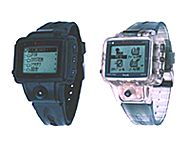|
Top Picks || Arts & Entertainment || Business & Economy || Education & Society ||
NEXT-GENERATION COMPUTERS: Wearable Computers Challenge Convention November 30, 1998  Next-generation watches do a lot more than just tell time. (Seiko Instruments Inc.) Portable notebook and hand-held computers have become commonplace items, but recently, a new breed of computer devices that one wears, rather than holds, is making its way onto the market. These new gizmos range in form from a wristwatch computer to a high-speed unit whose central body fits in a pocket and screen on the end of a headset. Makers are calling this the final frontier for portable computers. Is the age of the wearable PC truly upon us? Pocket Computer with a Headset Screen IBM Japan has a test product in the works that is the first truly wearable computer to boast the same speed and memory capabilities as the latest PCs. The main module is roughly the size of the palm and fits in a pocket. Data entry is performed by voicing commands into a microphone that is built into the hand-held control device. The screen, a thumb-sized, transparent, liquid-crystal display, is attached to a headset that holds it in front of the eye. Data is reflected in the display, just like a prompter used for speeches or news broadcasts. The whole device--main module, headset, controller, and cables--weighs in at around 450 grams (1 pound), significantly lighter than even the smallest notebook computers, which weigh about one kilogram (2.2 pounds). The maker claims that the display unit should not be distracting to the user. The Next Big Thing? Many computer users remain skeptical, though, claiming that wearable computers are impractical items that no one will want to use and limited in their applications. The past, though, is filled with examples of products thought doomed to failure from the start that later turned into hits. Lightweight, portable headphone stereos are just one notable example. When they were introduced around 20 years ago, critics argued that nobody would want to listen to music with headphones while walking, and that the product would be dangerous. Today, however, headphone stereos are enjoyed worldwide. Cellular phones are another example. Could wearable computers become the next product to defy the odds and become a mega-hit?
 Edited by Japan Echo Inc. based on domestic Japanese news sources. Articles presented here are offered for reference purposes and do not necessarily represent the policy or views of the Japanese Government. Edited by Japan Echo Inc. based on domestic Japanese news sources. Articles presented here are offered for reference purposes and do not necessarily represent the policy or views of the Japanese Government.
|
